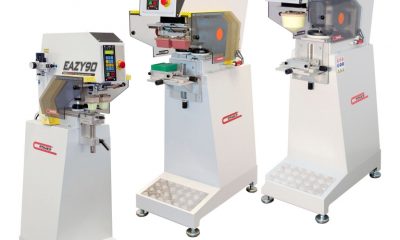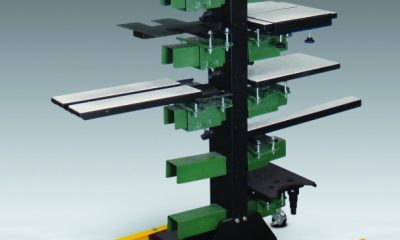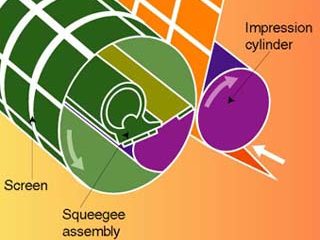Pad Printing
Published
22 years agoon
Several factors influence the performance of the pad-printing process, including the condition of the ink, the condition of the pad (including shape and hardness), ambient conditions, machine cycling parameters, and the etch depth of the plates (cliches) that contain the printing image. Most of these elements are relatively easy to define and control. However, measuring the etch depth of the imaged plate is an important function that is overlooked by most users and by a great many plate providers as well.
Several factors influence the performance of the pad-printing process, including the condition of the ink, the condition of the pad (including shape and hardness), ambient conditions, machine cycling parameters, and the etch depth of the plates (cliches) that contain the printing image. Most of these elements are relatively easy to define and control. However, measuring the etch depth of the imaged plate is an important function that is overlooked by most users and by a great many plate providers as well.
One reason why few printers or suppliers verify that etch depths fall within acceptable tolerances is because the equipment required to measure etch depth accurately is fairly expensive, costing $7000-10,000. We are fortunate to have such equipment at our disposal, and the tests we have conducted with it on behalf of our clients has led to several interesting revelations.
For optimum printing results, the etch depth on an open-etch (line art) plate should be between 25-28 microns and on a screened (halftone) plate, 30-32 microns. On plates we’ve measured for clients, particularly screened plates, we’ve recorded readings from 16-30 microns on the same plate. The overall range on plates we’ve sampled runs from 13-35 microns for screened plates and 18-30 microns for open-etch types. Such variations can have disastrous effects on print quality since the amount of ink deposited during printing changes with the depth of etch.
Producing an etched steel plate is not a simple process. It requires careful control in all aspects of production. Key requirements include verifying the quality of the steel and the resist coating, assuring correct exposure time and development procedures, checking etchant condition, and making sure that the etching and rinsing processes are being completed correctly. Mistakes or oversights in any of these areas can affect the etch quality of the finished plate. Only rigorous final inspection by the supplier of the etched plate will ensure individual plate quality and consistency from plate to plate.
Inconsistency from plate to plate is the main challenge that confronts pad printers. This inconsistency generally occurs because of a change in the concentration or temperature of the etchant. When either of these parameters change, so will the speed of etching. And when etching speed changes, so does the resulting etch depth. During printing, the effects of incorrect etch depth generally manifest as unexpected color changes, missing image details, excessive ink (if etch depth is too great), and premature ink drying on the plate or pad (when etch depth is insufficient).
If you are using steel plates, I would not recommend supplying your own plate material to the company that handles your etching needs unless you can provide complete etching characteristics for the material. The etching characteristics can vary dramatically based on the crystalline structure of the metal. The larger the crystals, the faster the material will be etched. As a rule, the harder the metal, the smaller the metallic crystals. One way to ensure that the steel plates you received from your etching supplier are correct is to insist on a certificate of conformity to accepted standards for every plate you buy. You’ll be surprised how quickly a manufacturer will get it right once you have rejected a plate or two.
For those who use photopolymer plates instead of steel, the depth of etch is equally important. The main difference here is that photopolymer plates are generally processed in house. If this is the case with your operation, you may want to invest in equipment to accurately measure etch depth yourself.
Silicone printing pads
The pad is the defining part of the pad-printing process, yet, it is often treated badly. Shape, hardness, and surface finish determine the pickup and transfer characteristics of each pad, and thus the quality of the pad-printing work.
It’s a relatively simple process to make molded silicone rubber pads. Molds can be made of vacuum-formed plastic, polished metal, or epoxy. The silicone rubber used in pad making comes from several sources and is either addition cured or condensation cured. The addition-curing process involves pouring silicone rubber into the mold and placing it in an oven to cure in as little as 2 hr. Condensation curing, on the other hand, is carried out at ambient temperatures and can take at least 24 hr to complete. Both curing methods deliver usable pads, but condensation-cured materials tend to give the best quality prints while addition-cured pads are more robust.
When it’s time to choose a pad, you should rely on several criteria. First, what shape is most suitable? Second, what hardness? Third, what material type? And fourth, what base plate material will be used and will it be molded or glued onto a wooden or aluminum base?
Assuming you know what pad shape you need, hardness is the first area to consider. The final hardness of the pad is affected by the characteristics of the base materials it is made from. The characteristics of the base materials will determine how much silicone oil the user will need to add to achieve the target hardness on press.
Ideally, you should measure the hardness when you receive new pads. Fortunately, the instrument to do this, called a durometer gauge, costs only $200-$300. It is effectively a calibrated spring in an indicator that measures the deflection caused when a probe presses down onto the surface of the pad. The device will give you a reading of Shore Hardness.
Pads are offered with hardness levels ranging from 15-70 Shore, but most applications require hardness levels from 40-55 Shore. The softest pads are typically used for prints that require extensive wraparound, while the hardest are specified for printing into recessed or concave areas when very high print definition is required.
Why is pad hardness so important? Consider that with a variation of only 4 Shore from the expected hardness level, you will begin to notice changes in the print produced by the pad. Some pads will be much farther from tolerance than this and significantly alter the printed results. In general, softer pads are less efficient in transferring ink. And pads using materials that have not been formulated correctly will harden over time. When pads are too hard, they do not compress and will not pick up the image properly.
Another matter to address concerns proper pad placement. You should ensure that the pad is attached to the base plate centrally and that the vertical centerline is at a right angle to the base. Frequently, when you replace a pad on the machine, you must also realign the new pad because it is not symmetrical to the base plate.
Proper care of pads also is very important. Always store them vertically on their bases, unless they are supplied in plastic shells that support them without touching the print surface. Keep them clean and do not expose them to strong solvents over an extended period. Remove dried ink with adhesive tape and then clean the pad with a mild solvent. Store pads at 65-75°F (18-24°C) and never lay one on top of another.
If you need to cover pads in storage to protect them from dust, use tissue paper and not plastic film, as plasticizers in the film may leach out and contaminate the pads. Some suppliers coat the pad surface with a gelatinous mixture to protect them in transit.
Keeping these considerations in mind, you can assure that your pads deliver the performance you expect. The benefits will be increased productivity and superior quality in the printed products you deliver to customers.

Subscribe

Magazine
Get the most important news
and business ideas from Screenprinting Magazine.
Most Popular
-

 Case Studies2 months ago
Case Studies2 months agoHigh-Density Inks Help Specialty Printing Take Center Stage
-

 Art, Ad, or Alchemy2 months ago
Art, Ad, or Alchemy2 months agoF&I Printing Is Everywhere!
-

 Andy MacDougall2 months ago
Andy MacDougall2 months agoFunctional and Industrial Printing is EVERYWHERE!
-

 Columns3 weeks ago
Columns3 weeks ago8 Marketing Mistakes Not to Make When Promoting Your Screen Printing Services Online
-

 Editor's Note2 weeks ago
Editor's Note2 weeks agoLivin’ the High Life
-

 Thomas Trimingham2 months ago
Thomas Trimingham2 months ago“Magic” Marketing for Screen Printing Shops
-

 Marshall Atkinson2 weeks ago
Marshall Atkinson2 weeks agoHow to Create a Winning Culture in Your Screen-Printing Business
-

 News & Trends1 month ago
News & Trends1 month agoWhat Are ZALPHAS and How Can You Serve Them in Your Print Business?






